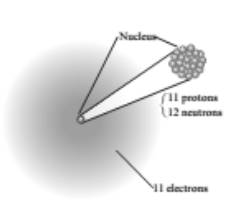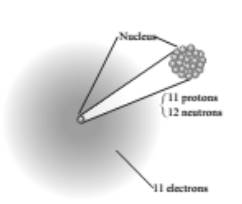
Concept explainers
Interpretation: The given table and figure needs to be completed.
Concept Introduction: Every matter is made of chemicals; the importance of chemistry is that it's the study of everything. Chemistry is all about how something interacts to affect the structure, composition, as well as knowing properties of substances.
Answer to Problem 6RQ
A complete figure is:

A complete table:
|
| |
| Name of the element | Sodium |
| Symbol of the element | Na |
| Mass number of the atom |
|
| Number of electrons in the atom |
|
Explanation of Solution
Protons are defined as a positively charged
An atom has a nucleus with a positive charge due to its protons and has electrons in the space surrounding the nucleus at relatively large distance from it. The structure shown in figure is of sodium. So, complete figure is:

According to this, a complete table:
| Atomic number of an atom |
|
| Name of the element | Sodium |
| Symbol of the element | Na |
| Mass number of the atom |
|
| Number of electrons in the atom |
|
Chemical representation of Sodium is Na. Atomic number of an
Chapter 3 Solutions
World of Chemistry, 3rd edition
- Q7. a. Draw the line-bond structure of the major product for the following reaction, if a reaction occurs, assume monohalogenation. b. Calculate the product ratios using the following information (hint: use the number of hydrogens in each category present to calculate the ratios). Chlorination: 1° Reactivity=1 2° Reactivity=4 Heat + Cl2 3° Reactivity=5arrow_forwardPlease correct answer and don't use hand rating and don't use Ai solutionarrow_forwardQ10: Alkane halogenation a. Give the name and structures of the five isomeric hexanes. Page 4 of 5 Chem 0310 Organic Chemistry 1 Recitations b. For each isomer, give all the free radical monochlorination and monobromination products that are structurally isomeric.arrow_forward
- Q9. The insecticide DDT (in the box below) is useful in controlling mosquito populations and has low toxicity to humans, but is dangerous to birds and fish. Hoping to alleviate the dangers, little Johnny Whizbang, an aspiring chemist, proposes a new version of DDT ("Bromo-DDT") and shows his synthesis to his boss. Will Johnny Whizbang's synthesis work? Or will he be fired? Assume there is an excess of bromine and polybrominated products can be separated. Explain why. CH3 Br2, light CBR3 ok-ok Br Br Br Br CI "Bromo-DDT" CCl 3 DDT (dichlorodiphenyltrichloroethane) CIarrow_forwardDifferentiate the terms Monotectic, Eutectic, Eutectoid, Peritectic, Peritectoid.arrow_forwardQ5. Predict the organic product(s) for the following transformations. If no reaction will take place (or the reaction is not synthetically useful), write "N.R.". Determine what type of transition state is present for each reaction (think Hammond Postulate). I Br₂ CH3 F2, light CH3 Heat CH3 F₂ Heat Br2, light 12, light CH3 Cl2, lightarrow_forward
- a. For the following indicated bonds, rank them in order of decreasing AH° for homolytic cleavage. Based on your answer, which bond would be most likely to break homolytically? (a) (c) H3C CH3 .CH3 CH3 CH3 (b) Page 1 of 5 Chem 0310 Organic Chemistry 1 Recitations b. Draw all the possible radical products for 2-methylbutane, and determine which bond is most likely to be broken.arrow_forwardA 5-m³ rigid tank contains 5 kg of water at 100°C. Determine (a) the pressure, (b) the total enthalpy, and (c) the mass of each phase of water.arrow_forwardQ8. Draw the mechanism for this halogenation reaction. Show all steps including initiation, propagation, and recombination. Cl₂, hv CI Br Br2, hv, heatarrow_forward
- Q6. Given the following alkanes, draw the most likely product to form upon monohalogenation with Br2 (keep in mind that this may not be the only product to form though). If the reaction was performed with Cl2 would there be more or less selectivity in the desired product formation? Why? (a) (b) (c)arrow_forwardQ4. Radicals a. For the following indicated bonds, rank them in order of decreasing AH° for homolytic cleavage. Based on your answer, which bond would be most likely to break homolytically? (c) CH3 CH3 H3C CH3 (a) CH3 (b)arrow_forwardQ1. (a) Draw equations for homolytic and heterolytic cleavages of the N-H bond in NH3. Use curved arrows to show the electron movement. (b) Draw equations for homolytic and heterolytic cleavages of the N-H bond in NH4*. Use curved arrows to show the electron movement.arrow_forward
 ChemistryChemistryISBN:9781305957404Author:Steven S. Zumdahl, Susan A. Zumdahl, Donald J. DeCostePublisher:Cengage Learning
ChemistryChemistryISBN:9781305957404Author:Steven S. Zumdahl, Susan A. Zumdahl, Donald J. DeCostePublisher:Cengage Learning ChemistryChemistryISBN:9781259911156Author:Raymond Chang Dr., Jason Overby ProfessorPublisher:McGraw-Hill Education
ChemistryChemistryISBN:9781259911156Author:Raymond Chang Dr., Jason Overby ProfessorPublisher:McGraw-Hill Education Principles of Instrumental AnalysisChemistryISBN:9781305577213Author:Douglas A. Skoog, F. James Holler, Stanley R. CrouchPublisher:Cengage Learning
Principles of Instrumental AnalysisChemistryISBN:9781305577213Author:Douglas A. Skoog, F. James Holler, Stanley R. CrouchPublisher:Cengage Learning Organic ChemistryChemistryISBN:9780078021558Author:Janice Gorzynski Smith Dr.Publisher:McGraw-Hill Education
Organic ChemistryChemistryISBN:9780078021558Author:Janice Gorzynski Smith Dr.Publisher:McGraw-Hill Education Chemistry: Principles and ReactionsChemistryISBN:9781305079373Author:William L. Masterton, Cecile N. HurleyPublisher:Cengage Learning
Chemistry: Principles and ReactionsChemistryISBN:9781305079373Author:William L. Masterton, Cecile N. HurleyPublisher:Cengage Learning Elementary Principles of Chemical Processes, Bind...ChemistryISBN:9781118431221Author:Richard M. Felder, Ronald W. Rousseau, Lisa G. BullardPublisher:WILEY
Elementary Principles of Chemical Processes, Bind...ChemistryISBN:9781118431221Author:Richard M. Felder, Ronald W. Rousseau, Lisa G. BullardPublisher:WILEY





